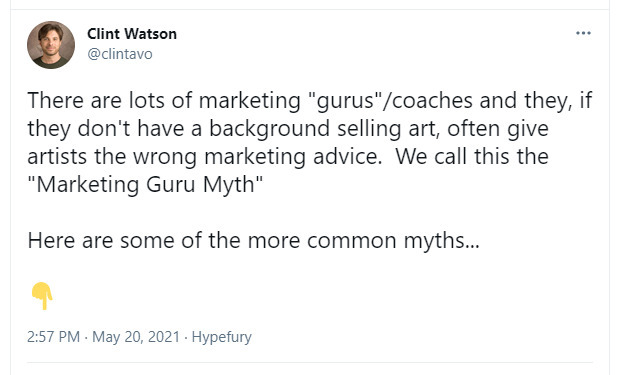After sharing the last article, I realized there are a lot of other "Marketing Guru Myths" that need to be addressed as well.
In today's article, I will highlight the top Marketing Guru Myths to get us started. Over the course of the next several weeks, I will be discussing these myths and the truths behind them in detail so be sure to keep reading!
By the way, I shared all 9 myths and their truths on Twitter first! For my latest thoughts on art marketing, posted daily please follow me.
Myth #1: You need to define your ideal customer.
The Truth: Lots of different types of people buy art.
Large companies can spend upwards of hundreds of thousands of dollars on market research to identify their ideal customer. And this works great when you're selling mass products with a clearly defined user or demographic.
Art is a much more personal purchasing experience. People of all walks of life fall in love with a particular artist's work. From young to old. From rich to poor. From working class to ivy league. The wide and varied appeal of a given work of art makes it, in most cases, almost impossible to define an "ideal customer".
Myth #2: Blogging will help you sell art.
The Truth: The benefit of blogging has moved to social media.
Blogging was a very effective way to put your art into the world 10 years ago. Social media (Instagram specifically) has really changed the way that people interact online. It acts as a curated gallery which allows you to share your work, your story and inspirations, and more to a mass audience.
We also all used to share stories about what was going on in our lives. All of that has moved to Facebook and Twitter. The "Golden Age" of blogging is dead.
Myth #3: You should use intrusive pop ups to increase signups to your newsletter.
The Truth: You're selling a luxury good and this is a mass market tactic.
I'm a strong advocate for utilizing email marketing in your overall marketing strategy. But using pop-ups and giving away freebies for email addresses will just pollute your email list when you're selling a high end product like art.
There are plenty of other ways that you can get people to sign-up for your email newsletter. Here's a few great tips to help get you started.
Myth #4: You need to work on ranking in search engines for lots of keywords.
The Truth: SEO is a lot of work, very expensive, and provides virtually no payoff for most artists.
SEO, which stands for "Search Engine Optimization", and is generally an attempt to rank well in Google for various keywords, is great for product and service marketing where people are actively searching for the "best landscaping company in X area".
The way that people search for and buy art is not, with a few exceptions, through high-ranking SEO pages. In short - search engine marketing works great for products that already have high demand, but you can never generate demand with search engine marketing.
Myth #5: Use an online virtual room to display your art.
The Truth: These are just annoying and slow, use the web in its native format.
Online virtual galleries have really started to pop-up in the last several months as a way to offer art collectors a "gallery experience" from the comfort of their own home. This may sound great in theory but the reality is that these online virtual rooms lack functionality and ease for the user.
People would much prefer browsing through your "gallery" of work on your website where they can easily navigate to each piece of artwork and learn more about it without the hassle of "walking" through an online virtual room.
Myth #6: You need "brand values".
The Truth Yuck. Most sentences with the word "brand" in them are marketing hype.
There IS a type of real branding power which takes an incredible amount of work and time. This isn't as simple as completing a "branding exercise" though. (If you're interested in learning more about this, click this link).
Myth #7: Create specific "SMART", "BHAG" goals and work backwards to achieve them.
The Truth: Specific goals create a danger of blinding you to the best opportunities, create systems of success instead.
Setting goals for your art that are too specific can result in missed opportunities and limiting your creativity. Ideally, what you're going for is to have big goals, weakly held. What I mean by that is, it's fine to shoot for the moon with your "goals", but if a better opportunity appears, be willing to drop the original goal in favor of the better one.
And don't forget to prioritize systems - for example, marketing and creating every day, with an attempt to continuously improve, will set you up for success when opportunity knocks. In other words, don't set a goal for "clean teeth" and to "be healthy". Just set up a daily system to brush your teeth and exercise.
Myth #8: Work in a series, paint for the market, etc.
The Truth: Create what inspires you and what makes your work unique.
It can be hard to separate the creative aspect and the business aspect of selling your art. But it's essential that you create what inspires you, without regard to what others want (outside of commissions, of course) while creating. That's what makes your art unique! And your uniqueness is what will set you apart. Of course, AFTER, you created a piece, then feel free to put your "business" hat on and figure out the best way to sell it.
Myth #9: Write product descriptions of your art for your target audience
The Truth: Write what inspired you to create the piece. Or the story of what's depicted in the piece.
Product descriptions are generally written on an ecommerce site from the perspective of the purchaser. The companies ask, "what's the best way to describe this shoe that will appeal to the most buyers (and rank highly in search engines)?"
For artwork, what's most important to us as buyers, is to know what inspired you. Use your story and the inspiration behind your art to really connect with your audience, because at the end of the day, that's what's going to sell your art.
Remember to keep reading for more on these 9 art marketing myths!
Until next time, remember that Fortune Favors the Bold Brush.
Sincerely,



